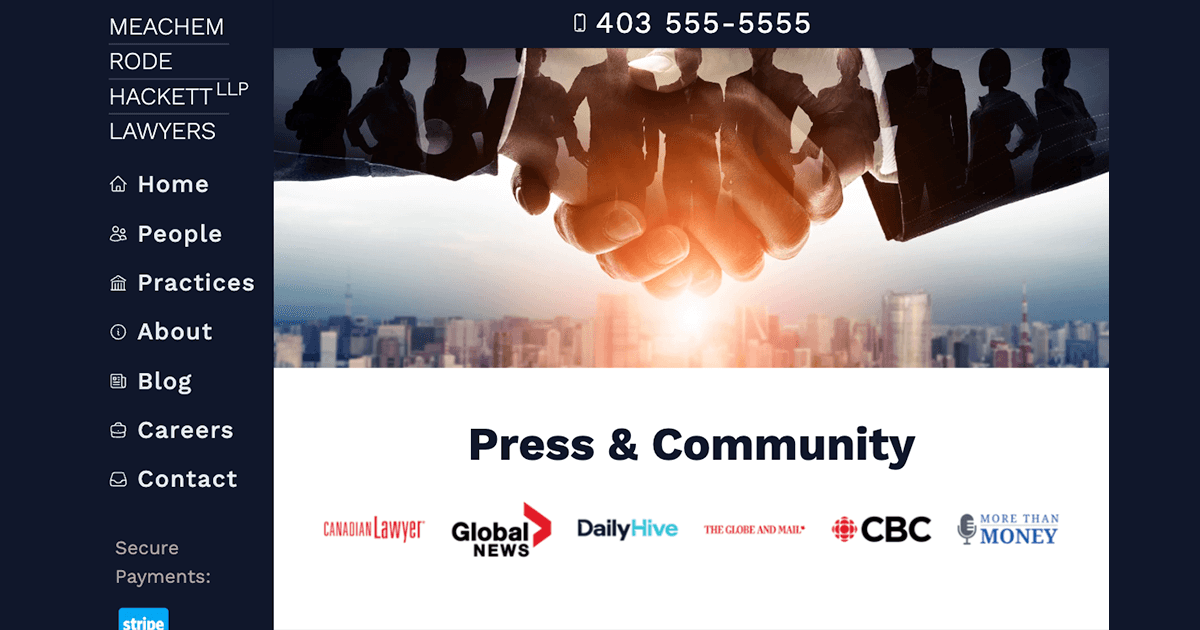
Optimizing Your Website: A Guide to Targeting Potential Employees
In today's business environment, a strategic shift towards talent acquisition can be a game-changer. Your website, and particularly its design, stands at the forefront of this approach. A website that's thoughtfully crafted with strategic content, professional design elements, and an optimized user experience is crucial in attracting the skilled professionals essential for growth. Here are key strategies to harness the power of your website and its design to build your ideal team:
Posted: January 22, 2024
Updated: September 07, 2025
Table Of Contents
- Introduction:
- Crafting Compelling Career Pages
- SEO for Job Listings
- Leveraging Blog Content
- Utilizing Social Media
- Employee Brand Ambassadors
- Responsive and Inclusive Design
- Showcasing Diversity and Inclusion
- Incorporating Interactive Elements
- Keeping the Website Updated
- Using Analytics and Gathering Feedback
Introduction:
In today’s fast-paced business world, attracting top talent is as crucial as client acquisition for sustainable growth. Your website plays a pivotal role in this process, acting not just as a digital front but as a reflection of your company's culture and values. A well-designed website can effectively draw in the professionals you seek to hire.
Your website often serves as the initial interaction point with potential employees. A design that's both professional and user-friendly, coupled with engaging content, sets the right tone from the outset. It's about creating an inviting online environment that communicates professionalism and potential.
Incorporating aspects of your company culture into your website is key. Prospective employees are often looking for a workplace that aligns with their values and aspirations. By using authentic images of your team, sharing success stories, and highlighting what makes your company unique, your website effectively narrates your company's story. It becomes a tool that not only showcases your achievements but also resonates with the ambitions of skilled professionals, making it a strategic asset in your talent acquisition efforts.
Crafting Compelling Career Pages
Overview
Your career page is often the first impression potential employees have of your company. Therefore, it should go beyond being a mere list of open positions. A compelling career page should communicate the essence of your company's culture, values, and unique selling points as an employer. This section will delve into how to make your career page engaging and reflective of what it's truly like to work at your company.
Content Strategy
- Company Culture and Values: Begin by vividly describing your company's culture and values. Use storytelling to bring these elements to life, perhaps through a day in the life at the company or through the journey of the company's growth and how it aligns with its core values.
- Engaging Content: Incorporate various forms of content such as videos, infographics, and photo galleries that showcase your workplace environment and day-to-day activities. This multimedia approach makes the career page more engaging and relatable.
- Employee Testimonials: Utilize testimonials from current employees. These could be written quotes or video interviews, offering insights into what they value about working at the company. Highlight diverse experiences to cater to a wide range of potential applicants.
Behind-the-Scenes
- Real-Life Glimpses: Share behind-the-scenes glimpses of company events, team-building activities, and daily operations. This transparency helps candidates visualize themselves as part of your team.
- Career Growth Opportunities: Outline clear paths for career advancement within the company. This could include professional development programs, mentorship opportunities, and examples of employees who have grown within the company.
- Unique Perks and Benefits: Don't forget to highlight any unique benefits or perks that set your company apart, like flexible working arrangements, wellness programs, or community involvement initiatives.
SEO for Job Listings
Introduction
Optimizing job listings for search engines is crucial in attracting the right talent. The use of relevant keywords and phrases ensures that your job openings appear in search results when potential candidates are looking for new opportunities. This section will cover strategies to optimize your job listings for maximum visibility.
Keyword Optimization
- Identifying Keywords: Conduct keyword research to understand what potential employees are searching for. This includes job-specific terms, industry jargon, and location-specific phrases.
- Incorporating Keywords: Seamlessly integrate these keywords into your job listings, including the job title, description, and meta tags. The key is to use them naturally, so the listings remain readable and engaging.
- Local SEO: If you're targeting candidates in specific geographical locations, include local keywords and phrases. This can significantly increase the visibility of your listings in local search results.
Content and Accessibility
- Job Description Clarity: Write clear, concise job descriptions that communicate the role's responsibilities and requirements. Avoid jargon or overly technical language that might deter potential candidates.
- Mobile Optimization: Ensure that your job listings are mobile-friendly, as a significant number of job seekers use mobile devices for job searches.
- Regular Updates: Keep your job listings up-to-date. Remove listings for filled positions and update descriptions as roles evolve. This not only helps with SEO but also reflects well on your company's professionalism.
Leveraging Blog Content
Introduction
Creating blog content tailored to your target employee demographic can be a powerful tool in attracting the right talent. This section will discuss how blog posts can not only enhance your SEO efforts but also establish your company as an industry leader and an appealing place to work.
Targeted Blog Topics
- Industry Insights and Trends: Publish articles that provide valuable insights into your industry. This positions your company as a thought leader and attracts professionals who are keen to stay abreast of industry developments.
- Career Development Content: Offer content that helps readers with their career growth, such as tips for professional development, industry-specific skills, or navigating career challenges. This kind of content can attract ambitious professionals who are looking to advance in their careers.
- Employee Success Stories: Share stories of employees who have grown and succeeded within your company. This not only humanizes your brand but also illustrates the real career progression opportunities available at your company.
SEO and Engagement
- Incorporating Keywords: Use relevant keywords naturally within your blog content. This enhances your SEO efforts, making your blog and, by extension, your career page more visible in search engine results.
- Interactive Content: Engage potential candidates by including interactive elements in your blog, like polls, quizzes, or comment sections. This can increase the time spent on your site, which is a positive signal to search engines.
- Regular Updates: Keep your blog updated with fresh content regularly. This not only helps with SEO but also keeps potential candidates engaged with your company over time.
Utilizing Social Media
Introduction
Social media platforms are crucial in today's recruitment landscape. This section will explore how to effectively use social media to showcase your company culture and advertise job openings.
Platform-Specific Strategies
- Choosing the Right Platforms: Identify which social media platforms are most popular with your target employee demographic. For example, LinkedIn is ideal for professional networking, while Instagram might be better for showcasing company culture.
- Content Tailoring: Tailor your content to suit each platform. For instance, LinkedIn posts should be more professional and industry-focused, while Instagram posts can be more casual and visually engaging.
- Employee Involvement: Encourage employees to share their work experiences and company events on their personal profiles. This not only extends your reach but also adds authenticity to your employer brand.
Engagement and Analytics
- Engaging with Followers: Actively engage with your audience through comments, messages, and shares. This helps build a community around your brand and can make your company more attractive to potential employees.
- Analyzing Performance: Use analytics tools provided by social media platforms to understand what kind of content resonates with your audience. This data can inform future content creation and recruitment strategies.
- Regular Updates: Consistently post content to keep your audience engaged and informed about your company's latest news and job openings.
Employee Brand Ambassadors
Introduction
Empowering your current employees to act as brand ambassadors is a highly effective and authentic way to attract potential candidates. This section will discuss how to encourage and facilitate employees in sharing their work experiences and job openings.
Encouraging Employee Advocacy
- Employee Advocacy Programs: Develop a structured program that encourages employees to share company news, job openings, and their personal experiences working at the company on their social networks.
- Training and Guidelines: Provide training and clear guidelines on how employees can represent the company online. This ensures consistency in messaging and protects both the employees and the company's reputation.
- Incentivizing Participation: Consider offering incentives for employees who actively participate in advocacy programs. This could be in the form of recognition, rewards, or professional development opportunities.
Leveraging Authentic Stories
- Storytelling: Encourage employees to share their stories and testimonials about working at the company. This could include their career growth, work-life balance, or participation in company events and initiatives.
- Diverse Perspectives: Highlight stories from a diverse range of employees to appeal to a broad spectrum of potential candidates. This showcases the inclusivity and varied opportunities available within your company.
- Content Support: Provide employees with content ideas, templates, or even pre-written posts to make it easier for them to share. However, ensure that their personal voice and authenticity are retained.
Responsive and Inclusive Design
Introduction
In today’s digital world, having a mobile-friendly and accessible website is imperative, especially for attracting top talent. This section will cover the importance of responsive design and inclusivity in your digital presence.
Mobile-Friendly Design
- Responsive Web Design: Ensure your website is designed to be responsive, meaning it adjusts seamlessly to different screen sizes, particularly mobile devices. Many candidates use mobile devices for job searching, making this a crucial feature.
- Speed and Performance: Optimize your website’s loading times and performance on mobile devices. Slow or poorly performing websites can deter potential candidates and negatively impact your search engine rankings.
- User Experience: Focus on creating a smooth and intuitive user experience on mobile. This includes easy navigation, readable content, and straightforward application processes.
Inclusive Web Design
- Accessibility Standards: Adhere to web accessibility standards to ensure your website is usable by people with various disabilities. This includes features like screen reader compatibility, keyboard navigation, and alternative text for images.
- Inclusive Language and Imagery: Use language and imagery that reflects a diverse and inclusive workplace. Avoid stereotypes and ensure that the content resonates with a wide audience.
- Feedback and Improvement: Regularly gather feedback on your website’s usability and inclusivity, and make improvements based on this feedback. This demonstrates your commitment to diversity and inclusion.
Showcasing Diversity and Inclusion
Introduction
Illustrating a commitment to diversity, equity, and inclusion (DEI) is vital in attracting a diverse pool of candidates. This section will focus on how to effectively showcase your company's DEI efforts on your digital platforms.
Highlighting DEI Initiatives
- Dedicated Website Sections: Create specific sections on your website to highlight your company’s diversity and inclusion policies, initiatives, and achievements. This can include information about employee resource groups, community outreach programs, and diversity training.
- Success Stories: Share success stories that demonstrate the impact of your DEI initiatives. This could be employee experiences, community projects, or partnerships with diverse organizations.
- DEI in Action: Illustrate your commitment through real examples, such as participating in diversity job fairs, hosting inclusive events, or implementing inclusive hiring practices.
Inclusive Content and Imagery
- Diverse Imagery: Use imagery on your website and social media that reflects a diverse workforce. Avoid tokenism by ensuring that the diversity shown is genuine and representative of your company.
- Inclusive Language: Use language that is inclusive and respectful of all backgrounds. This includes gender-neutral language, cultural sensitivity, and avoiding stereotypes.
- Regular Updates and Transparency: Keep information about your DEI efforts up-to-date and be transparent about your progress and areas for improvement. This demonstrates an ongoing commitment rather than a one-time effort.
Incorporating Interactive Elements
Introduction
Interactive elements on a career page can significantly enhance candidate engagement. This section will explore innovative ways to incorporate interactivity into your digital recruitment strategy.
Engaging Interactive Features
- Virtual Office Tours: Offer virtual tours of your office space or facilities. This helps candidates visualize the work environment and feel a connection to the company.
- Interactive Quizzes: Create quizzes that help candidates determine if they are a good fit for your company or for specific roles. This not only engages candidates but also aids them in their job search process.
- Live Q&A Sessions: Host live Q&A sessions or webinars where potential candidates can interact with HR representatives or team members. This provides a personal touch and allows for real-time engagement.
Benefits of Interactivity
- Enhanced Candidate Experience: Interactive elements can make the job search process more engaging and informative, leading to a positive candidate experience.
- Insights into Company Culture: Through interactive features, candidates can gain deeper insights into your company culture and what it’s like to work at your company.
- Increased Engagement and Time on Site: Interactive elements can increase the time candidates spend on your website, which can positively impact your site’s search engine ranking.
Keeping the Website Updated
Introduction
A regularly updated website reflects an active and evolving company. This section will discuss the importance of keeping your digital presence fresh and current.
Regular Content Updates
- Latest Company News: Share recent company news, achievements, or milestones. This keeps your website dynamic and gives candidates a sense of your company’s growth and activity.
- Up-to-Date Job Listings: Regularly update your job listings to ensure they are current and remove filled positions promptly. This helps maintain credibility and improves the candidate experience.
- Event Information: Post information about upcoming events, webinars, or open houses. This can attract potential candidates and provide additional engagement opportunities.
Dynamic Website Features
- Blogs and Articles: Continuously add new blog posts or articles that are relevant to your industry and appealing to potential candidates. This not only helps with SEO but also establishes your company as a thought leader.
- Employee Spotlights: Feature different employees regularly. This can help candidates see the diversity and talent within your organization and understand the types of people they could be working with.
- Feedback and Iteration: Actively seek feedback on your website and make iterative improvements. This shows that you value user experience and are committed to continual improvement.
Using Analytics and Gathering Feedback
Introduction
Utilizing analytics and gathering feedback are crucial for understanding how your career pages and job listings perform. This section will outline how to effectively use this data to improve your recruitment strategy.
Analytics Insights
- Tracking Visitor Behavior: Use analytics tools to track how visitors interact with your career pages. Look at metrics like page views, time spent on page, and bounce rates to gauge interest and engagement.
- Conversion Tracking: Monitor how many visitors to your career pages are actually applying for jobs. This can help you understand the effectiveness of your content and design in converting visitors into applicants.
- SEO Performance: Regularly review your website's performance in search engine results. Use this data to refine your SEO strategies and improve visibility.
Gathering and Implementing Feedback
- Candidate Surveys: Conduct surveys with candidates who have interacted with your website. Ask about their experience, what they liked, and areas for improvement.
- Continuous Improvement: Use the feedback and analytics insights to make continuous improvements to your website. This could involve tweaking the design, updating content, or enhancing the application process.
- Responsive Adaptation: Be responsive to the changing trends and preferences of job seekers. Regularly update your recruitment strategies to align with these changes.
More Blog Posts...
Speed matters, how tech has made websites faster and better in 2022
Centralizing your marketing efforts through a website marketing hub can be the key to unlocking maximum impact. Your website should serve as the central hub, seamlessly connecting all your marketing channels to create a unified and powerful marketing engine
A look at the making of artist David L Massey's website. The website features a storefront.
Your landing page is your brand’s first shot to grab attention and make an impression. It’s where web design and digital marketing join forces to create instant impact. With a smart, brand-aware design, you can turn curious visitors into loyal customers and fast-track your business growth. Make your landing page work harder!
Discover the best website design solutions for Red Deer small businesses and brands. Get a high-converting, attention-grabbing website that drives growth and puts your business in the spotlight.





